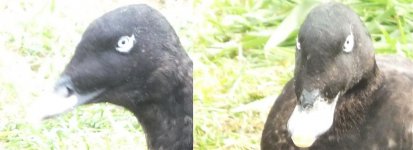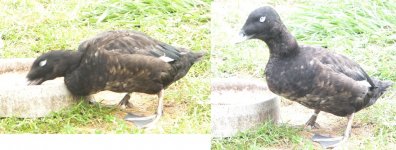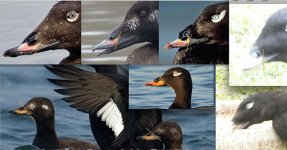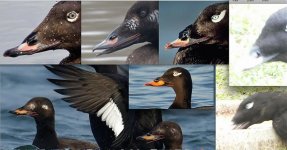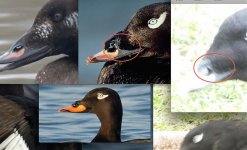-
Welcome to BirdForum, the internet's largest birding community with thousands of members from all over the world. The forums are dedicated to wild birds, birding, binoculars and equipment and all that goes with it.
Please register for an account to take part in the discussions in the forum, post your pictures in the gallery and more.
You are using an out of date browser. It may not display this or other websites correctly.
You should upgrade or use an alternative browser.
You should upgrade or use an alternative browser.
Scoter ID- American White-Winged or Velvet? (1 Viewer)
- Thread starter Joern Lehmhus
- Start date
More options
Who Replied?SteveClifton
Well-known member
Are there any other images, no matter how poor/over-exposed?
Joern Lehmhus
Well-known member
david kelly
Drive-by Birder

Hi Joern
I think Velvet, the crescent under the eye is not extensive enough. The bill isn’t right for either fusca or deglandei, possibly a photographic artefact. However, it looks mote like a Velvet’s.
David
I think Velvet, the crescent under the eye is not extensive enough. The bill isn’t right for either fusca or deglandei, possibly a photographic artefact. However, it looks mote like a Velvet’s.
David
arcadillor
Well-known member
white winged to me
Andy Adcock
Worst person on Birdforum

Hi all,
I am sorry to post a photo of a captive bird but the ID is important to me. Photos are rather bad and overexposed and the bird was photographed end of July, which doesn´t make ID easier.
Best regards, Jörn
Despite guidelines which say 'no captive birds', the mods seem to be ignoring the guideline regarding nests and eggs so why not......
Just off to the local arboretum, I'll post a dozen shots of what I find there for ID.
And who keeps a Scoter, how do you feed them!
Last edited:
Joern Lehmhus
Well-known member
Anybody else with an answer helpful to me. please?
Arcadillor, it would be great if you could explain why whitewinged ?
Arcadillor, it would be great if you could explain why whitewinged ?
Joern Lehmhus
Well-known member
andyadcock and mods, I excuse for posting a captive bird, but in the past we have had a few other captive bird IDs over the years at BF in similar circumstances;
and while I agree it is not useful and in the meaning of BF to have zoo photos posted here, i think the ID of American whitewinged versus Velvet scoter isn´t a trivial one and this bird`s correct ID would at least help my and perhaps also some other people`s understanding.
I also think this is a different situation than closeup photos of active nests and eggs. That restriction is sensible. There would be a risk to derstroy a breeding, but you don´t have that with this bird.
This is not my captive bird, and will stay a captive bird no matter what I do.
So the photo in itself is not harming a bird in any way.
If this thread is still thought to be better removed, mods, you are free to do it.
While we are at the ID topic, andyadcock, you have given your ID thoughts to birds in about any bird family in the forum, so you surely also have an opinion here?
and while I agree it is not useful and in the meaning of BF to have zoo photos posted here, i think the ID of American whitewinged versus Velvet scoter isn´t a trivial one and this bird`s correct ID would at least help my and perhaps also some other people`s understanding.
I also think this is a different situation than closeup photos of active nests and eggs. That restriction is sensible. There would be a risk to derstroy a breeding, but you don´t have that with this bird.
This is not my captive bird, and will stay a captive bird no matter what I do.
So the photo in itself is not harming a bird in any way.
If this thread is still thought to be better removed, mods, you are free to do it.
While we are at the ID topic, andyadcock, you have given your ID thoughts to birds in about any bird family in the forum, so you surely also have an opinion here?
Andy Adcock
Worst person on Birdforum

andyadcock and mods, I excuse for posting a captive bird, but in the past we have had a few other captive bird IDs over the years at BF in similar circumstances;
and while I agree it is not useful and in the meaning of BF to have zoo photos posted here, i think the ID of American whitewinged versus Velvet scoter isn´t a trivial one and this bird`s correct ID would at least help my and perhaps also some other people`s understanding.
I also think this is a different situation than closeup photos of active nests and eggs. That restriction is sensible. There would be a risk to derstroy a breeding, but you don´t have that with this bird.
This is not my captive bird, and will stay a captive bird no matter what I do.
So the photo in itself is not harming a bird in any way.
If this thread is still thought to be better removed, mods, you are free to do it.
While we are at the ID topic, andyadcock, you have given your ID thoughts to birds in about any bird family in the forum, so you surely also have an opinion here?
Velvet Scoter, reduced eye patch and just a slight bulge at bill base.
SteveClifton
Well-known member
Velvet Scoter, reduced eye patch and just a slight bulge at bill base.
The same could be said of an immature drake White-winged Scoter.
Oh, and by the way JL, you are 'off the hook' (in my book at least!). Interesting bird...
Last edited:
Mark Lew1s
My real name is Mark Lewis
I don’t think it can be a Velvet - the feathering at the base of the upper mandible (I.e. just behind the nostril) is pretty much a right angle, which fits the other two much better than Velvet. Not sure beyond that though!
Andy Adcock
Worst person on Birdforum

The shape and extent of the yellow band on the bill, to me, is indicative of Velvet as per illustrations in Reeber.
Edit: Unless I overlooked it, we haven't been told where this bird is, can Scoters be legally taken as captives?
Edit: Unless I overlooked it, we haven't been told where this bird is, can Scoters be legally taken as captives?
Last edited:
Joern Lehmhus
Well-known member
Yes, that´s the problem: the shape of the orange patch on the bill is much like Velvet, but the angle at the base of the upper mandible is closer to American Whitewinged. The eyepatch is again more like Velvet.
This paper here also includes the pictures from the Reeber book and photos:
https://www.birdguides-cdn.com/cdn/...d scoters id photo guide_birdwatchfeb14lr.pdf
The bird was in Weltvogelpark Walsrode in Germany in the seaduck aviary. I know from breeders that there are small legal captive populations of scoter species and all other seaducks, kept and propagated by specialists. As far as I know these ducks require special foods and quite clean conditions and relatively large water bodies with very good water quality to survive and breed in captivity. Scoters sold to Walsrode were bred 2012/13 in captivity. They were reported as whitewinged scoters.
So everything should have been clear.
BUT I read some years ago a short notice in a paper that Walsrode had also taken in some seaducks including scoters that had been oiled or otherwise injured at the coast and could not be released later on. I do not have any more information and certainly do not know if this piece of information was true.
Seeing this single scoter in the seaduck aviary with King eider, Spectacled Eider, Longtailed duck and Barrows Goldeneye made me wonder what species it actually was. (If this is one of the birds bred 2012/13 it can not be an immature male in 2017, when I took the photo)
This paper here also includes the pictures from the Reeber book and photos:
https://www.birdguides-cdn.com/cdn/...d scoters id photo guide_birdwatchfeb14lr.pdf
The bird was in Weltvogelpark Walsrode in Germany in the seaduck aviary. I know from breeders that there are small legal captive populations of scoter species and all other seaducks, kept and propagated by specialists. As far as I know these ducks require special foods and quite clean conditions and relatively large water bodies with very good water quality to survive and breed in captivity. Scoters sold to Walsrode were bred 2012/13 in captivity. They were reported as whitewinged scoters.
So everything should have been clear.
BUT I read some years ago a short notice in a paper that Walsrode had also taken in some seaducks including scoters that had been oiled or otherwise injured at the coast and could not be released later on. I do not have any more information and certainly do not know if this piece of information was true.
Seeing this single scoter in the seaduck aviary with King eider, Spectacled Eider, Longtailed duck and Barrows Goldeneye made me wonder what species it actually was. (If this is one of the birds bred 2012/13 it can not be an immature male in 2017, when I took the photo)
Last edited:
Joern Lehmhus
Well-known member
Flanks are browner than breast and undertail coverts - shouldn´t that also indicate American whitewinged?
SteveClifton
Well-known member
Yes, that´s the problem: the shape of the orange patch on the bill is much like Velvet, but the angle at the base of the upper mandible is closer to American Whitewinged. The eyepatch is again more like Velvet.
I put together this graphic earlier to illustrate this, and came to the conclusion that your bird has features consistent with both Velvet and American White-winged Scoter (didn't have any useful data on Stejneger's to hand). It shows 2 immature drake and 1 adult drake White-winged above, and below there are 2 immature drake Velvets and 1 adult drake.
The orange lines on the first hopefully show the angle of the rear edge of the orange bill patch. Note that on Velvet they slope the opposite way to White-winged. Your bird appears closest to White-winged, but it's not a perfect match.
The red lines on the second (same) graphic show the angle created by the lower edge of the bill's upper mandible and the lower edge of the feathered area behind the bill. Your bird appears closest to White-winged (closer to parallel) but again, it's not a perfect match.
On the last close-up, note the similarity of the shape of the nostril structure and its proximity to the rear edge of the orange bill patch compared to the adult drake White-winged Scoter-looks very similar IMO (much closer together than on Velvet).
I can't place much value on the shape of the eye crescent as the bird appears not to be a full adult, but note that there is some white flecking behind the clear area of white beneath the eye, which mirrors the shape on WWScoter.
On a captive bird such this, you wonder if this could be a product of mixed genes between two different species or races? but very difficult to prove!
One last point, as Andy pointed out the colour of the nail, although bleached out, I agree it looks closest to Velvet Scoter! Go figure...
Attachments
Last edited:
Joern Lehmhus
Well-known member
I put together this graphic earlier
On the last close-up, note the similarity of the shape of the nostril structure and its proximity to the rear edge of the orange bill patch compared to the adult drake White-winged Scoter (closer together than on Velvet).
Sorry Steve, but where´s the graphic?
EDIT: Ah, now i can see it!
RichieTwitchy
YNWA
Despite guidelines which say 'no captive birds', the mods seem to be ignoring the guideline regarding nests and eggs so why not......
Just off to the local arboretum, I'll post a dozen shots of what I find there for ID.
And who keeps a Scoter, how do you feed them!
Sorry to jump in here and bring Andy's point up again - but I agree with Andy!
And I've fallen foul of the rules myself on a couple of occasions but I've learnt from that
And Joern you seem like a nice person with an honest request BUT if a rule is in place that states NO RHUBARB PIES and you bring along a rhubarb pie for no matter what reason then you are breaking those rules.
I think we either have rules that are followed otherwise what is the point of those rules?
Whether it's for the members of a forum to vote on and change those rules is another thing, but whilst they are in place then we should all abide by them.
Again, it is a genuine request from an honest forum member but it IS breaking the rules.
So where do we go from here? Am I being unfair?
Joern Lehmhus
Well-known member
Very interesting Steve, Many thanks. This is convincing. Whitewinged it is.
And thank you to all who gave their knowledge to help.
concerning this "rhubarb pie" , mods please decide what to do.
And thank you to all who gave their knowledge to help.
concerning this "rhubarb pie" , mods please decide what to do.
Last edited:
SteveClifton
Well-known member
Sorry to jump in here and bring Andy's point up again - but I agree with Andy!
And I've fallen foul of the rules myself on a couple of occasions but I've learnt from that
And Joern you seem like a nice person with an honest request BUT if a rule is in place that states NO RHUBARB PIES and you bring along a rhubarb pie for no matter what reason then you are breaking those rules.
I think we either have rules that are followed otherwise what is the point of those rules?
Whether it's for the members of a forum to vote on and change those rules is another thing, but whilst they are in place then we should all abide by them.
Again, it is a genuine request from an honest forum member but it IS breaking the rules.
So where do we go from here? Am I being unfair?
As a general principle, I agree with the sentiments here.
We see on a weekly basis requests for IDs of wildfowl which (to me at least) are obviously captive or of captive origin. If I'm honest, I rarely if ever get involved with them, but I do notice that JL regularly does and I believe he does so with the best of intentions: to educate and help others that perhaps aren't so experienced, and therefore don't realise that such birds 'aren't allowed' on this forum.
For that reason I'm personally prepared to bend the rules a little here, especially as his post highlights some issues we could all face as field birders, and hopefully learn something in the process.
Joern Lehmhus
Well-known member
There´s already one thing in what you say , Steve:
How to behave towards photos of birds that are originally of captive origin ?
we have quite a lot of waterfowl hybrids flying around in Europe and surprising hybrid combinations are possible in the wild- allthough more likely to happen in captivity (or with an originally captive bird that has escaped, as one parent).
I think it is important to know these and make them aware to birders. In 1994 , I had two such problems with wild hybrids in the same holiday. I would have been glad to find somebody to help me there.
Concerning fertile hybrids: For example, I think in the future we may be facing a "ruddy duck problem" with barnacle and canada geese. Hybvrids are fertile and canada genes are entering the barnacle goose population. Already now, hybrids are often reported as cackling geese by people who do not have experience with them.
But here you also often have the problem that a bird might stem from captive environment- should we then not ID it?
There are also other situations where rules may be bent a little, e.g. if somebody has found a nest with young birds that has been torn down by a storm , and wants advice what birds those are and what to do.
I think we have had that also a few times during the years I follow BF.
Furthermore if somebody sees a new bird and asks for help and it turns out it is an escapee (or a freeflying captive parrot/goose /egret /ibis---a few examples here !), should we then cease help?
In my opinion there are several "borderline cases" to the rules. However, if somebody would violate the rules with always posting photos of captive birds and would be banned for that; I would agree.
Bending the rules a little in some cases can be useful; and i think that is one reason why, beside the rules, we need moderators to decide.
How to behave towards photos of birds that are originally of captive origin ?
we have quite a lot of waterfowl hybrids flying around in Europe and surprising hybrid combinations are possible in the wild- allthough more likely to happen in captivity (or with an originally captive bird that has escaped, as one parent).
I think it is important to know these and make them aware to birders. In 1994 , I had two such problems with wild hybrids in the same holiday. I would have been glad to find somebody to help me there.
Concerning fertile hybrids: For example, I think in the future we may be facing a "ruddy duck problem" with barnacle and canada geese. Hybvrids are fertile and canada genes are entering the barnacle goose population. Already now, hybrids are often reported as cackling geese by people who do not have experience with them.
But here you also often have the problem that a bird might stem from captive environment- should we then not ID it?
There are also other situations where rules may be bent a little, e.g. if somebody has found a nest with young birds that has been torn down by a storm , and wants advice what birds those are and what to do.
I think we have had that also a few times during the years I follow BF.
Furthermore if somebody sees a new bird and asks for help and it turns out it is an escapee (or a freeflying captive parrot/goose /egret /ibis---a few examples here !), should we then cease help?
In my opinion there are several "borderline cases" to the rules. However, if somebody would violate the rules with always posting photos of captive birds and would be banned for that; I would agree.
Bending the rules a little in some cases can be useful; and i think that is one reason why, beside the rules, we need moderators to decide.
Last edited:
Users who are viewing this thread
Total: 2 (members: 0, guests: 2)




